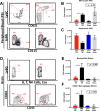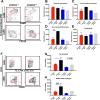Nonclassical Monocytes Mediate Secondary Injury, Neurocognitive Outcome, and Neutrophil Infiltration after Traumatic Brain Injury
- PMID: 28993515
- PMCID: PMC5679470
- DOI: 10.4049/jimmunol.1700896
Nonclassical Monocytes Mediate Secondary Injury, Neurocognitive Outcome, and Neutrophil Infiltration after Traumatic Brain Injury
Abstract
Traumatic brain injury (TBI) results in rapid recruitment of leukocytes into the injured brain. Monocytes constitute a significant proportion of the initial infiltrate and have the potential to propagate secondary brain injury or generate an environment of repair and regeneration. Monocytes are a diverse population of cells (classical, intermediate, and nonclassical) with distinct functions, however, the recruitment order of these subpopulations to the injured brain largely remains unknown. Thus, we examined which monocyte subpopulations are required for the generation of early inflammatory infiltrate within the injured brain, and whether their depletion attenuates secondary injury or neurocognitive outcome. Global monocyte depletion correlated with significant improvements in brain edema, motor coordination, and working memory, and abrogated neutrophil infiltration into the injured brain. However, targeted depletion of classical monocytes alone had no effect on neutrophil recruitment to the site of injury, implicating the nonclassical monocyte in this process. In contrast, mice that have markedly reduced numbers of nonclassical monocytes (CX3CR1-/-) exhibited a significant reduction in neutrophil infiltration into the brain after TBI as compared with control mice. Our data suggest a critical role for nonclassical monocytes in the pathology of TBI in mice, including important clinical outcomes associated with mortality in this injury process.
Copyright © 2017 by The American Association of Immunologists, Inc.
Conflict of interest statement
The authors declare no competing financial interests.
Figures






References
-
- Faul M. Traumatic Brain Injury in the United States: Emergency Department Visits, Hospitalizations and Deaths 2002–2006. Centers for Disease Control and Prevention, National Center for Injury Prevention and Control; Atlanta (GA): 2010.
-
- Whitlock JA, Jr, Hamilton BB. Functional outcome after rehabilitation for severe traumatic brain injury. Archives of physical medicine and rehabilitation. 1995;76:1103–1112. - PubMed
Publication types
MeSH terms
Substances
Grants and funding
LinkOut - more resources
Full Text Sources
Other Literature Sources
Molecular Biology Databases

